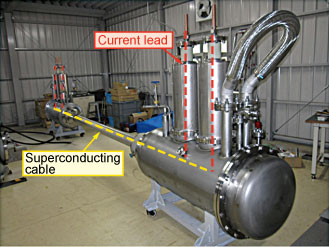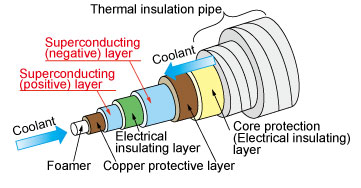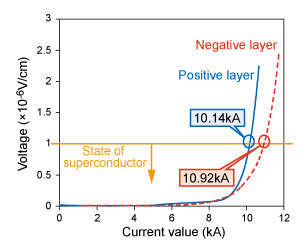2. Production of superconducting cable for railways
- A five meter long superconducting DC 1.5kV, 8kA cable was made to meet practical specifications for use on railway lines.
- The results from electric conductivity tests verified that there were no transmission losses and that electricity could flow at over 10 kA.
Superconducting cable is being developed in order to save energy in electric feeder systems. A superconducting cable with zero transmission resistance if used as transmission cable for DC electric supply to railways would reduce regenerative cancelling and transmission loss. Other expected advantages include load levelling and reducing voltage drops between substations and consolidation of substations. In addition, passing the rail return current through the superconducting cable, making electrification bi-directional would reduce magnetic field leakage and could solve the problem of electrolytic corrosion.
Adapting the superconducting cable to the existing DC electrical system on congested lines around cities would require a current capacity of 8-12 kA. Therefore, a 5 m, 8kA class superconducting cable for DC 1.5kV was developed to meet real line specifications (Fig.1). The developed cable has coaxial geometry and transmits both feeder current (positive layer) and the return current (negative layer). Go-Return (counter flow circulation) cooling, which appears as if there is only one circulation path, was used as the two way coolant system inside the cable.
Electrical transmission tests were carried out demonstrating that there was no transmission loss and that a current of over 10kA could be achieved (Fig2). This cable is among the most advanced of its kind in the world. The present research was funded by the Ministry of Land, Infrastructure, Transport and Tourism.

Fig.1 Superconducting cable for railways
Fig.2 Structure of Superconducting Cable
Fig.3 Results of electrical current tests